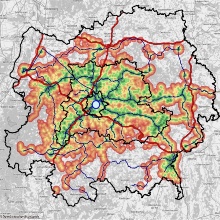• • Models and methods for planning sustainable transport services
Major changes are needed to make transport and mobility more sustainable and to achieve climate targets in the transport sector. In addition to technical solutions in the field of vehicle technology (powertrain turnaround), we need a mobility turnaround that leads to changes in mobility behavior. The task of the mobility transition is to set the framework conditions in such a way that the changes in location of people and goods are associated with the lowest possible emissions.
The Chair of Traffic Planning and Traffic Control Technology wants to contribute to sustainable mobility that meets the demands of society and people through application-oriented research and the education of students. To this end, the following research topics are being worked on:
- Planning of Transport Networks
Computer-aided methods for designing traffic route networks for pedestrian, bicycle and motor vehicle traffic. Methods for designing routes, timetables and circulation plans in public transport. - Eeffects of Measures
Methods for determining the effects of measures on road users (journey times, costs), on the transport system (modal split, transport performance, travel time required) and on the environment (emissions). - Transport Demand Modeling
Mapping of market-based measures (CO2 prices, taxes), regulatory measures (transit bans, environmental strips, speed limits) and new transport offers (ridesharing, car sharing, autonomous vehicles) in models for forecasting traffic demand.erkehrsnachfragemodellierung.
Instruments and measures for sustainable transport:
"In order to achieve the climate goals in the transport sector, we need technical solutions and framework conditions that change mobility behavior."



